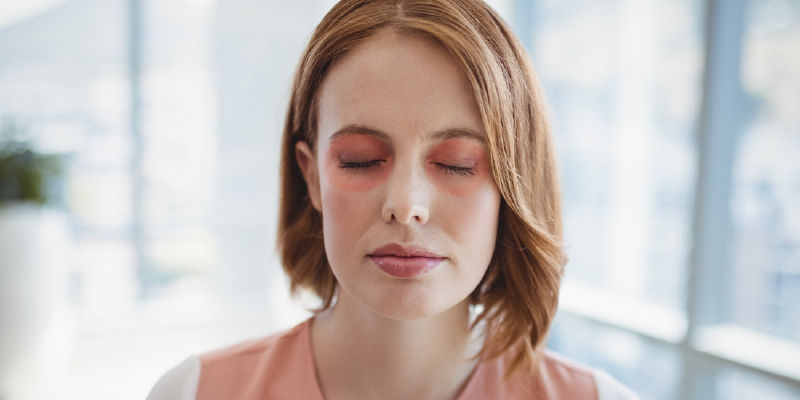Rosacea is a chronic inflammatory skin disease that affects over 14 million people in the United States alone [1]. Although this condition is becoming more widely known and understood, many people, even those with rosacea, often do not realize that there are four subtypes of this condition, one being ocular rosacea.
Ocular rosacea, which affects your eyes, typically accompanies the same telltale signs of skin-related rosacea. Or it could be an indicator that other facial signs of rosacea will develop in the future.
Are you struggling to manage ocular rosacea or aren’t sure if you could have this condition? Take a look at this overview of what ocular rosacea is, how to spot it and which treatment options might be the most appropriate.
What Is Ocular Rosacea
Ocular rosacea is a subtype of rosacea that affects the eyes, usually resulting in red, itchy and burning eyes [2]. It is possible to have multiple subtypes of rosacea at one time. So you may see skin symptoms such as pimple-like pustules on the skin, red flushing of the skin and reddened, hardened skin on and around the nose.
Like many chronic inflammatory conditions, the exact cause of rosacea is still unknown. However, there are a few likely possibilities, including:
- Genetics
- Sun exposure
- Microscopic mites called demodex
- Certain bacteria [3]
In addition, certain environmental factors can trigger flare-ups of rosacea and ocular rosacea symptoms. Some of the most common rosacea triggers are:
- Sun exposure/warm temperatures
- Emotional stress
- Heavy exercise
- Certain medications
- Hot beverages like coffee, tea or hot chocolate
Signs and Symptoms of Ocular Rosacea 
If signs of ocular rosacea occur before any secondary skin symptoms show up, it can be tricky to distinguish this condition from others like blepharitis or dry eye disease, which can produce similar symptoms. That said, some of the most notable signs and symptoms of ocular rosacea to look for are:
- Dry, burning or red eyes
- A “gritty” or “sandy” sensation in the eye
- Sensitivity to light
- Blurred vision
- Red, swollen eyelids
If you’re experiencing any of these symptoms on a regular basis, it is best to make an appointment with your eye specialist for an accurate assessment and diagnosis of your eye disorder. Once you know more about what could be causing your symptoms, you can take the necessary steps to treat and/or manage your condition.
How Is Ocular Rosacea Treated and Managed?

Currently, there is no known cure for rosacea or its subtypes. However, many eye experts recommend adopting a regular eyelid cleansing routine to help manage ocular rosacea and keep its symptom flare-ups under control. In addition, there are a number of oral and topical medications that can help to diminish the visible skin symptoms of rosacea, like redness and flushing. Depending on which specific symptoms you’re dealing with, your eye doctor may recommend combining various treatment options or trying just one to start.
When cleansing your eyelids to help alleviate signs of ocular rosacea, you need to be careful not to use a product that will result in even more inflammation and eye irritation. Choose a gentle, yet efficient product like Cliradex Light Foam that has been designed specifically for use near the sensitive eye area.
Cliradex is the pioneer in making a commercially available eyelid cleanser that isolates 4-Terpineol. T4O is the compound found in tea tree oil with a demonstrated capacity for eliminating Demodex mites, which have been linked with skin-related and ocular rosacea.
You can learn more about how to most effectively use Cliradex products for improved eye hygiene here.
In Summary
Although there isn’t a cure for ocular rosacea or other subtypes of rosacea, these conditions can be effectively managed. Get an accurate diagnosis, make lifestyle changes, use proper eyelid, and eye hygiene and the most appropriate prescription medications based on rosacea type.




